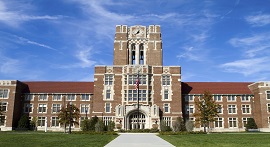Art History, Criticism and Conservation
Overview
As the modernist artist Piet Mondrian once said, "Art does not create objects for practical use; art provides images for spiritual needs." Art History, then, studies both the way we’ve struggled to fulfill those needs, and how those needs have changed over time. It examines the way that we have seen the world around us since we started looking. In the study of art history, the art object is more than just something to be admired. It is a living part of the past that exists with us in tangible form today.
The study of the history of art, of art criticism, and of conservation of art, is not merely about enjoying works of beauty, but also about understanding them in the context of their own time. This includes understanding how and why they were created, how they were meant to be seen, and whether they were meant to last. A student in an Art History program will undertake not just the study of the history of objects and their makers, but the history of the religious, cultural, political and social forces which, along with the artist, brought those objects into being—objects that, after all, constitute our contemporary cultural life.
Students in such programs will be required to learn how to analyze, arrange, appraise, catalogue, describe, exhibit, preserve and restore art objects. They have to become familiar with varying methodologies including deconstructionist theory, feminist theory, Marxist theory, psychoanalytic theory and modernist theory, while at the same time developing an eye for pictorial and spatial analysis.
Note: Not all Art History programs have a conservation component. In order to concentrate in conservation, students occasionally have to enroll in a separate degree program. In such programs, you will most likely learn all of the above, but also be required to develop a background in chemistry, archaeology and studio art.
Degree Information
A Master’s of Arts degree in Art History, Criticism, or Conservation will typically take between one and a half and three years, and will involve a thesis in addition (usually) to oral and written exams. The M.A. will often require familiarity with at least one foreign language.
A Master’s of Science degree in Conservation will typically take around three years, and will feature a research or technical study paper and comprehensive exams. Language knowledge may or may not be required.
The Ph.D. can take as few as three years (rare) or as many as seven, and will involve mastery of one or more foreign language, as well as a dissertation and oral defense.
Questions to Ask Yourself When Choosing a Degree Program
- Where is the program located, and will I be able to see the art I want to study?
- Is the focus more on Western or non-Western art?
- Does the program focus more on conservation or on historical analysis?
- Who are the faculty members and what are their areas of expertise? Where have they studied?
- What sort of access do you have to faculty members, especially any big names?
- What about the students? What are they doing?
- What about the alumni? Have they stayed local? Do they support the school once they've left?
- With which other departments does the Art History department cooperate?
- What sort of assistantships, grants, and other financial aid opportunities are available?
Career Overview
Whatever art historians end up doing, much of their labor is often as devoted to increasing public understanding of art as it is increasing scholarship on the existing body of work. Thus, many of them end up as curators, library directors, archivists, or reference librarians. If you pursue a career as a curator, you can expect not only to design and present exhibits, but also be responsible for obtaining the objects, whether through purchases, soliciting gifts, or exchanges with other museums, galleries, and private collectors.
Conservators, (or conservationists), naturally, must have all of the knowledge of an art historian as well as an understanding of the material bodies of the works of art, and how they can be kept together for posterity. Using X-rays, microscopes, black light, chemical testing and other lab equipment, conservators examine objects and determine their condition and how to best preserve it. They’re also responsible for keeping extensive records of their work. Conservators will often specialize in one specific type of object or one material—like old books or carved ivory or baskets—in order to narrow the field a little.
Career/Licensing Requirements
There are no specific licensing requirements for a career in Art History, Criticism, and Conservation.
Salary Information
Archivists, curators and museum technicians can expect to earn somewhere between $25,000 and $46,000. The median income is about $32,000, and only about 10 percent earn any more than $61,000. Conservators or restorers can expect to earn in a similar range.
Related Links
Association for Art History
The Association for Art History provides listings of conferences, publications and employment opportunities.
International Council on Monuments and Sites
The International Council on Monuments and Sites is an international non-governmental organization. The ICOMOS website provides information on conservation principles, techniques, and policies.
American Institute for Conservation of Historic and Artistic Works
The American Institute for Conservation of Historic and Artistic Works provides accredited institutions, meetings and conferences, information on how to become a conservator and what’s new in the world of conservation.
VIEW ALL Art History, Criticism and Conservation SCHOOLS BY PROGRAM
MAJORS
RELATED GRADUATE PROGRAMS
RELATED CAREERS
SAMPLE CURRICULUM
Introduction To The Study Of Art History
19Th-Century Art
20Th-Century Art
African Art
Architectural Theory & Practice
Architecture Of The English Renaissance
Baroque Art
Conservation Methods
Curatorial Training
Early Renaissance Art
European Romanticism
Feminism And The Visual Arts
Greek And Roman Art
Medieval Art
Medium And Media
Museum Education And Interpretation
Featured MBA Programs For You
Connect with business schools around the globe and explore your MBA options.

Best Business Schools
Check out our lists of best on-campus and online MBA programs and find the best program for your career goals.
Explore Graduate Programs For You
Ranked master’s programs around the globe are seeking students like you to join their programs.
Med School Advice
Get medical school application advice, USMLE prep help, learn what to expect in med school and more.


